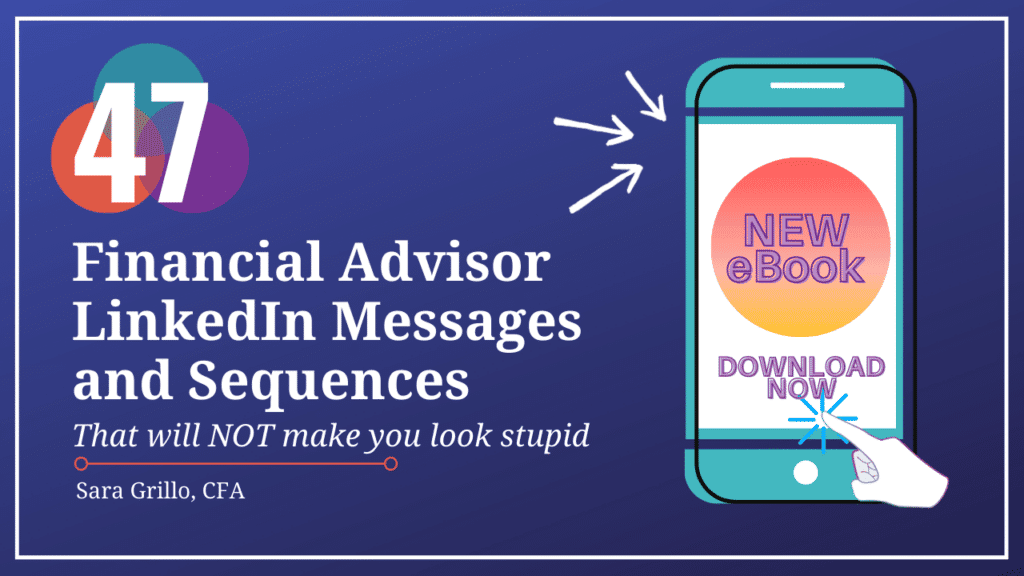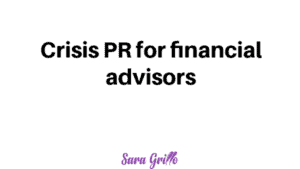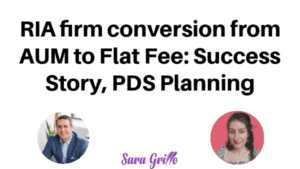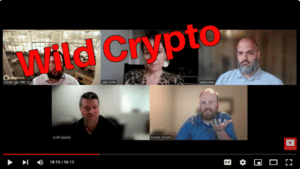Podcast: Play in new window | Download
In this podcast with John Anderson of SEI, you will learn what the future of financial planning is likely to be. We will ponder these questions:
- How will financial planning change the client experience in 10 years?
- What is the future of financial planning?
- What forward-minded planners should be and are doing now to prepare their businesses for the future?
- What is a culture of innovation look like for a financial advisor firm?
- Will consumers actually adapt to using digital tools or is that just lip service?
But before we get into it…
For those of you who are new to my blog/podcast, my name is Sara. I am a CFA® charterholder and I used to be a financial advisor. I have a weekly newsletter in which I talk about financial advisor lead generation topics which is best described as “fun and irreverent.” So please subscribe!

What is the future of financial planning?
0:00:00.0 SARA GRILLO: Hey, what’s up everybody, Sarah here. In this podcast, we’re gonna be talking about what financial planning is gonna be looking like in 10 years, and I’ve got John Anderson of SEI with me today, what to
0:00:10.9 JOHN ANDERSON: Do… Thanks for having me there, looking forward to being… Having this conversation.
0:00:15.5 SARA GRILLO: Yeah, so Hey, everyone, look, I know it’s a crazy time and it’s strange to think about having a conversation about what the profession is gonna look like in 10 years, but I promise you there are themes that are really relevant to the short term… Right now, it’s April 1st, 2020, and we’re in the midst of the coronavirus, market is volatile and web siring, but everybody… There are some great lessons in here, if you could just hang on and listen to the show, so John, where did… I know this is something a theme that you talk a lot about, what the profession is gonna look like in 10 years, where did the impetus for this discussion come from…
0:00:55.3 JOHN ANDERSON: Sure, thanks. Well, first of all, again, thanks for having me here, I’m thrilled to be a part of this podcast, and even more importantly, I think the conversation that we’re gonna have today is absolutely relevant today because everything I talked about, and that’s gonna happen by 2030, I think is being accelerated, so I’m really looking forward to this conversation. But let me step back a little bit about a year ago, about a year ago. Last week, I think it was, I was having this conversation with a number of members from the FPA, and one of the things we were talking about is kind of this future of the industry as we look around, we look at, for example, the retail, the retail market, more malls and work stores were closing in 2019, then closed in 2008 and 2009, we saw a dramatic shift, the consumers now empowered to go online to look for any size, shape, manufacturer, quantity, color, we’re looking… This empowered consumer, we started thinking about how is that gonna affect the advisory business, because we’re trained consumers to go online, we’re training consumers to think about pricing options and to think about quality and to think about getting things at their way, and our business, the advisor business tends to be very advisor-centric rather than consumer focus, so what we started to do is think about how can we find a look into the future to say, What does a client-centric business look like, what does a consumer focus business look like in the advisory world? So we did a survey, we deny what we called forward thinking financial advisory firms, and picked by the spa, we then did an online survey with advisors, I think there was somewhere around 450 advisors that worked on the survey, and we came out with this paper in October of 2019 held advisory firms, 2030, the innovation impart.
0:02:40.7 JOHN ANDERSON: And what we wanted to look at in that paper is to say, number one, let’s take a look at the current market, how were advisors focusing on the future, and then take a look at the future and to say what’s gonna happen to that business? What does it look like? And as I said, today, I think it’s even more relevant because we’re being pushed into that advisory firm of 2030 right now, with the ability of advisors working at home, with creating workflows, with using technology. It’s a very interesting time.
0:03:08.5 SARA GRILLO: So how will financial planning change the client experience?
0:03:14.3 JOHN ANDERSON: Well, I think it’s changing now. Well, we looked at in the paper as we first took a look at and where advisors are today, one of the first things we ask is, Are they in fact planning? Are they planning for the future… Surprisingly, a majority of advisors don’t have a business plan, they may have a growth plan, they may have a couple of tactics that they use, but they really have no… Look out into the future to say, what does this business look like? And how can I focus on that? They don’t do segmentation. If they do segment, I shouldn’t say that they don’t do segmentation based on consumer needs, they do segmentation based on their needs. I’d love to talk about segmentation, I talk about it in a regular basis, but I always think that segmentation is talk backwards, they think about AUM or revenue per client, they don’t think about what’s important to the client, if we start segment based on what’s important to the clients that are what’s important to the consumer, we have a whole new look at the business, we have a whole new look at opportunities in the business, we have all…
0:04:09.9 JOHN ANDERSON: We look at the clients and what their names are, we can talk about pricing, we can talk about service models, we can talk about use of technology, but when I think about the way that the business looks today, again, it’s very, very advisor-driven, even down to things like planning and technology. In fact, 93% of advisors, if I remember the statistics, right? Still met with their clients almost exclusively in their offices, forcing the consumer to come to their office and you know you think about it, I talked about stores close, I talked about malls closing in a retail environment, people were forcing to go to malls and stores instead of going to shop where they’re more comfortable, and I think this is kind of that accelerated change that we’re starting to see, so that’s kind of where we saw advisor firms happening today in focus, so then we look at the future state of the business and what are planners thinking about the profession, what are they doing now to prepare… We ask them if it’s easier or harder to grow in the future, looking at their technology, looking at their human resources, how are they evolving? And as we started to dig into that, what we found for the most part, is that while advisors have goals, they don’t necessarily have plans, so for example, we ask the planners to rank business goals, and we all talked about growth in AUM and adopting workflows and things like that, but for the most part, what we found is, is it didn’t necessarily use the new tactics, for example, that may be out there.
0:05:39.6 JOHN ANDERSON: So what I’m basically saying is, we have to where his growth can come from and unbelievably, the survey that came back was, I could have answered this 10 years ago or 15 years ago. They talked about client referrals, they talked about centers of influence, they talked about educational events, and they really didn’t take into consideration, again, this change in consumer, they didn’t take into consideration new market specifically around specialization, or… For example, millennials, we found very, very few people suggested they were gonna grow their business by expanding the services that they put into place, which I was kind of surprised with what we heard from them in survey, after survey is that they do intend to customize client experiences based on specific needs, that the clients are gonna have different needs, so they’re going to evolve with them, but they were more reactive instead of proactive. And as I started to think about this business, as I started to think about this consumer change, I think if we’re not focused on paying attention to the future, we’re not focused on seeing these clients evolve. I don’t think that old model works, and not only do I not think that will not work, I think a lot of advisors are gonna be left in the dust, are trying to react when, and frankly, it may be already too late to amisom of the things that we had asked about some of the things we talked about, we started to do a follow-up paper, so about maybe six weeks ago is so we launched the follow-up paper to advisory firms of 2030, and in that paper, what we did was we profiled six advisors that we’re growing.
0:07:18.8 JOHN ANDERSON: We’re growing quickly, but they were growth by specialization, so if the first paper was called advisory firms of 2030, the innovation imperative, this one was called advisory firm a 2030 growth through specialization. And what we wanted to do in that paper is really kind of dig in and to say, Here’s an example, I’m sorry, a five advisors who are focused on very specific financial advisor niches, how they’ve broadened their services to just those niches, and they’re doing a very good job of whether it’s content marketing, whether it’s using technology, whether it’s growing their business by specializing on a specific area rather than being a generalist, and their clientele is reaching out to them from all around the country because… What are we doing? We’re going out, we’re searching for advice, we’re searching for something with a specific need, these five advisors have created niches that are now finding themselves being sought at set out from clients around the country.
0:08:23.0 SARA GRILLO: So what are planners doing now to prepare their businesses for the future?
0:08:28.6 JOHN ANDERSON: Well, what we suggest they do versus what they’re doing is a little different, what we suggest that they do is start looking beyond just being tactical, think about horizons longer than 12 months. One of the things that those eight firms that we talked about at the beginning, those specialist advisory firms, those progressive advisory firms, they all had a very clear-cut value proposition, they knew what their value proposition was, they knew how it resonated with their target audience, and if we think about increasing am is a goal that we have. Think about, does that value proposition resonate today with your target audience and will it resonate down the road with your target on you? What I can tell you personally, is that the investment side of this business is becoming more and more commoditized every single day, the ability for one manager to perform another manager over a 20-year period is relatively negligible. The ability for you to be a specialist in the investment side of the business is very negligible today because there’s so much competition in so many different products that are out there, so the investment side of our business is becoming more and more commoditized.
0:09:37.2 JOHN ANDERSON: Frankly, the planning side of our businesses become more and more commoditized as well, you can find firms that are doing basic generic general financial planning, they may take offense to that, which you can find basic generalist financial planning for 30 basis points from one firm for 300 a month subscription fee from another firm, so that general financial plan and a general investment management is pretty commoditized here, if you want to charge a premium, if you do have actual value, you’re gonna have to focus on being a specialist, you’re in it, to focus on having a value proposition that is gonna clearly resonate with your target audience, so we start with first looking beyond the tactic and think longer than 12 months, we then move in to say, What are you waiting for? Actually sit down and do a plan. What does that 10-year strategic plan look like to shift away from being in general to a specialist, and how do you anticipate the client needs, and how do you attract younger clients, most of the firms that we talked about, I really paid no attention to the Millennials which is a much bigger market, frankly, than the baby boom generation, we talked a lot about segmentation and the papers, segmentation to me, is adapting to client needs based on experiences rather than what you wanna deliver, so by focusing on a niche, and we even created a tool a persona worksheet.
0:10:58.8 JOHN ANDERSON: A worksheet is maybe coming up with a hypothetical or an ideal client, one that you can dig into, one that you can understand what the client’s needs are, what their wants are, what the implications are for planning, the implications are for services and the implications for pricing, with those types of personal, one is you can also use those personas for marketing, in fact, one of the people that we profiled in the growth paper has created, I think what she called the retire and Ricardo and the saving saris. She put together these profile, these people, and she marketing target marketing to those types of people. We talk a lot about assessing the technology means, if you think about the technology news, this is where I’m really seeking advisors having to step up today instead of by 2030, and look at the way that you’re doing more with less, think about the gaps in the technology set, think about what you need to achieve scale, when we think about human resources, when we think about staffing, when you think about people, this is a business by specialization, that we’re gonna actually be able to streamline some of the services that we provide because we’re doing it over and over again.
0:12:10.0 JOHN ANDERSON: But we’re now dealing with a client that may be in California or New York or Texas or Minnesota, somewhere other than where we are, so think about the technology and think about the uses of technology and incorporate that technology plan into your strategically. I think ultimately, it comes down to really listening more to your clients, understanding whether you create an advisory board, focus group, some sort of client survey, but look at what they are attracted to or admire with regard to the service model that you deliver, maybe even go outside of the gate and say, What other service business out there do you appreciate and why, what are they doing to keep you loyal, what are they doing to the fact that you’re paying a premium for… So if we listen more of the clients, I think we’re gonna have the ability to understand what they’re looking for and create our service model around that. Hopefully, that kind of makes sense. I know I’m going pretty quick here. Right.
0:13:12.7 SARA GRILLO: So how do you see this working in the future for how planners will handle human resources and technology issues?
0:13:21.1 JOHN ANDERSON: Well, in our surveys that we looked at, most of the advisors that we talk to are looking for a fully bundled solution, they want one that has integration between, for example, the CRM, the financial planning software, and a custodial platform. Unfortunately, we say we want that, but we look around the industry and there’s so many desperate systems that are out there that people are buying without really having a technology plan based on to it, they’re not looking at how it’s gonna impact my work flows, how it’s gonna impact the service model that I deliver, how it’s gonna impact my staff, how it’s gonna impact the delivery of value that I have and how my clients are gonna interact with that. So I think one of the first things when I think about technology is to understand, do I have a technology stack or do I have a technology pile and really do a technology audit on your business? Again, I think in today’s environment, we’re all forced to figure out, does that technology stack work and is it something that all flows? So I think this out, coming out of the recent challenge that many of us are in, I think one of the first things that our advisors are gonna do is they’re gonna come back and they say, Okay, the system that I had over the 30 days or 45 days, God forbid, any longer self-quarantine or isolation that I’ve had, what were the pros and the cons of the solution that I have? And I think if we think about that now, we think about that 30 days from now, we now start to develop a plan around how we’re going to integrate technology down the route.
0:14:55.6 JOHN ANDERSON: Again, I think it’s very important that we understand from the client’s perspective as well as the advisory perspective, on the HR side, there’s more advisors that are… CPS over the age of 70 that are under the age of 30. I think you’re gonna start to see a little bit more consolidation in the business today, and you have to figure out, are you going to be acquiring… Are you going to be acquired? What does that do to the staff… One of the things that we found from the growth by specialization side of our paper was that many of the advisors who are focused on this niche or focus on the specialization can actually have a better streamlined process for their business. If they can create a system that allows them to do more repetitive tasks and even think, almost read the minds of their clients, if I have an existing client that looks like all my other clients, I can tell them what’s gonna happen in their future, and I can tell them that about 58 years old, they’re gonna start thinking about, Do I have enough and it might be ready for retirement, I can tell you that I have a large part of my net worth, for example, an employee stock options or something to that effect, and then I’m gonna have to worry about AMT and I’m gonna have to worry about other types of solutions, so by telling more of that specialist, you can streamline your back office, you can create more efficient, you can incorporate technology either in a better solution for the existing clients that you have, but I think there’s gonna be a lot of waves in that, the one caution though that I see is the advisors that are thinking about acquiring businesses, there’s a lot of challenges that I’ve seen when we acquire the wrong business, so by doing your dinosaurs
0:16:40.2 SARA GRILLO: Right. Leaning, my friends.
0:16:44.8 JOHN ANDERSON: Does it fit… Right, right. But does it fit into the system that I already have? And I see rather than buying the whole business went up by a portion, why not buy the… If I’m focused exclusively on executives and professionals, why not just by that portion of the business, and I think it’s a much better solution for themselves.
0:17:07.7 SARA GRILLO: So what will a culture of innovation look like 10 years from now? What is the future of financial planning?
0:17:14.5 JOHN ANDERSON: Well, I think that’s a great question. Most of the people that they think about innovation, they think about acquiring more technology, when they think about technology, they think about ways to increase our technology budget or to buy another gadget. I’m fortunate that I have a lot of hindsight here, I started in the business back in… Wow, 1985. And I remember in the 80s and people were focused on product and mainly around tax shelter, in the 90s, it was the Internet was gonna change everything that we see, and all sorts of different funds and products that were coming out in the 90s and 2000s, and today I look around and I go to a lot of conferences, and it seems like every other one is a tech vendor that’s got this lawal product that’s out there, and I think we’re biting technology today without knowing the impact of the technology that we already own, so to me, a culture of innovation is one that thinks about the future of the experience with the client, not the product that they can buy, I think the culture of innovation is one that can change, to morph into what the client’s looking for, frankly, sometimes before they even know what they’re looking for, I think it’s one that focuses on increasing awareness, it’s content marketing, is developing a service for the client that they have to have, not that the commodity that they are told they should have.
0:18:45.2 SARA GRILLO: So where does the consumer come in here with all of this… Well, consumers adapt to digital tools, I remember I wrote this blog on, well, Amazon, Be the next wealth management force, and it was really kind of perplexing for some people to think about because I don’t know where financial advisors get this idea, but a lot of them have the idea that their clients don’t use technology, I think it’s a big wake up at… No, but they do. They’ll say this, you know, and I think it’s… ’cause I think, to be honest with you, it’s just a reflection of how they feel about themselves, because I will do blogs or whatever, and I’ll get these advisors that wanna print out the blog, write out their comments and then scan it back over email, it’s like use track changes, do I learn how technology works, so I feel like it’s almost the excuse of, Well, my clients will never use a digital financial planning tool if they would… Never communicate over social media. I think that’s kind of a reflection of how they feel about it. Not necessarily how the client feels, so… But that is a question, will these consumers adapt to digital tools or is it always gonna be a paper-written
0:20:02.8 JOHN ANDERSON: Industry? So the analogy that I like to give is if you would have gone 15 years ago and you would have gone to taxi drivers around the US, and you said, What can I do to create a better experience? They would have talked about the vehicle, they would have talked about making things a little easier for them, but they didn’t talk about it was a ride sharing app that allowed me to pay via credit card that allowed to track where the driver was, to monitor the system to split the fears with somebody else and make life dramatically easier, if you talk to retailers, whether it was at a store or a mall, and you would have said, What do I need to do to me might increase my sales, you would have talked about parking and you have talked about getting the latest fashions or whatever it is, what they didn’t talk to is with the consumer, I like in my office at home, shopping online, I don’t wanna go to the mall. I haven’t used a tactic can probably five years. Because it’s just that much easier. So what do I think about the future and where the consumers, the consumers already marked moving with their feet, they’re already seeing millions, hundreds of millions of dollars going to the robot-esque advisors.
0:21:19.2 JOHN ANDERSON: Now, I don’t think there’s gonna be some human erection, so I don’t call them roboadvisors as much as I call them virtual advisors, it’s leveraging technology to make it easier to communicate with your clients, but I think the true robots haven’t really done as well as the ones that we call the virtual advisors, the one that still have a human, but if I’m a little wealthier than the average client of these virtual advisors, I’m probably gonna still wanna talk to the same person, rather than a 1-800 call number for my VP or my plan. What I’m probably gonna wanna do is I wanna incorporate a personal touch with all the technology, and it’s very, very easy to do these days, it’s just understanding what the client’s looking for, where the client move towards this, they’re moving now and they’re moving very, very fast, so what we need to do is we need to make sure as advisors that we can incorporate the technology to allow the consumer to have what they want when they want it, but when it comes to the real individual, personalized advice, that…
0:22:27.0 JOHN ANDERSON: Specialization is gonna be key because I’m gonna be typing in not what does a middle age retiree look for, I’m gonna say What does a junior executive with equity compensation and college education plan. I’m gonna start profiling exactly what I’m looking for and see who else is out there, and go is empowering that and all the search engines are making it easier to eat, find the people that I want to talk to. For the solutions that I need.
0:22:58.9 SARA GRILLO: Alright, John, well listen, if we should probably wrap now, given that everyone has to get back to watching the news and panicking about the markets… I’m not trying to make a joke out of it, but it’s just crazy. Everything right now, so I don’t wanna take too much longer, John, But sincerely, I wanted to thank you. Is there any way that people can get a hold of the report that you’ve mentioned in this call…
0:23:30.0 JOHN ANDERSON: Sure, of course, the easiest way to get a hold of it is really go to the SEI website, which is www.seic.com, and just type in advisory firms 2030, you’ll be more… There’ll be a couple of different places that you can go to find it, it’s in our Knowledge Center. It’s easy to download free, so I would be more than happy to have that out for anybody that wants to read it.
0:23:53.0 SARA GRILLO: Right. Okay, thank you so much. And so, how can people get in touch with you if they have more questions?
0:24:01.1 JOHN ANDERSON: Well, that’d be great. . My email address is very easy. It’s janderson@seic.com
0:24:14.2 SARA GRILLO: Or you can just find them on LinkedIn everybody, since I hope you’ve been listening to In a podcast and you know that I’ll love me. Do you know anything about the man, Twitter? I get them on LinkedIn, my preference. Alright, John, thank you so much, everybody. Please subscribe to the show and we will see you next time.
Sara’s upshot
What’d ya think of my podcast on the future of financial planning? Was this helpful?
If yes…
Learn what to say to prospects on social media messenger apps without sounding like a washing machine salesperson. This e-book contains 47 financial advisor LinkedIn messages, sequences, and scripts, and they are all two sentences or less.

You could also consider my financial advisor social media membership which teaches financial advisors how to get new clients and leads from LinkedIn.

Thanks for reading. I hope you’ll at least join my weekly newsletter about financial advisor lead generation.
See you in the next one!
-Sara G
Podcast transcript is edited from original recording.





